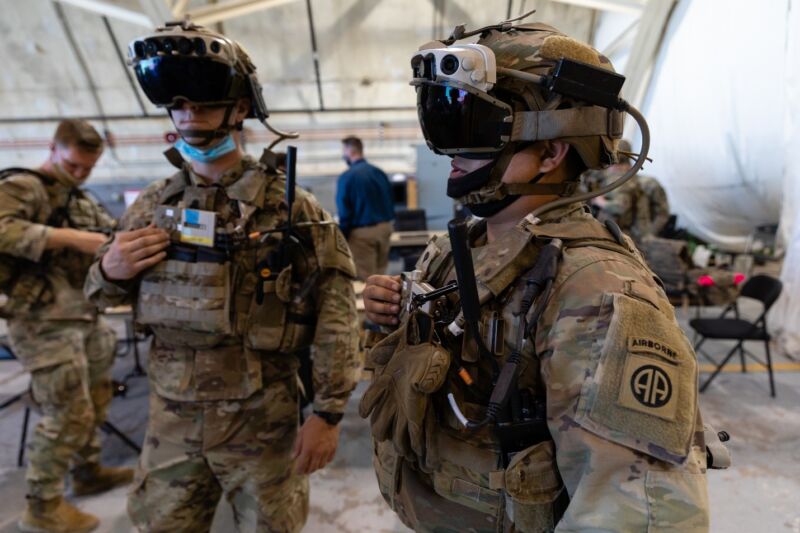"The devices would have gotten us killed," an Army report claims.
SCHARON HARDING - 10/13/2022,

The US Army is testing a custom headset based off of Microsoft's HoloLens.
Microsoft and the US Army are continuing to explore how to make mixed reality an aid rather than a hindrance for soldiers. A US Army report that Bloomberg and Business Insider claim to have accessed indicates that Microsoft's HoloLens-based headsets, during testing, made soldiers feel physically ill and more vulnerable to harm.
Insider said an excerpt of a US Army report on a "recent" field test dictated to it by an unnamed employee included a soldier who tested the tech saying, "The devices would have gotten us killed."
This was reportedly in relation to the light that emits from mixed reality headsets like the HoloLens.
"Criticisms, according to the employee who dictated to Insider excerpts of this report, included that the device's glow from the display was visible from hundreds of meters away, which could give away the position of the wearer," Insider reported on Tuesday.
Bloomberg said it accessed a summary made by the Pentagon's testing office of a 79-page report detailing a field test with the HoloLens-like headsets that occurred in May and June. In it, US soldiers reported experiencing nausea, headaches, and strained eyes, which could all affect real-life missions. Neither Bloomberg nor Insider specified if these experiences represented the majority.
However, Bloomberg reported that among those who experienced "mission-affecting physical impairments," 80 percent started feeling ill in under three hours.
Insider also reported solider discomfort that sounds similar to what a lot of consumers complain about when getting used to a head-mounted display (HMD): the weight of the hardware limiting movement and a limited field of view. But while concern around these issues can be deterrents to potential buyers of gaming and entertainment gadgets, like the Quest Pro, they can be the difference between life and death for members of the military.Advertisement
Insider cited an anonymous "Microsoft employee briefed about the event," who said the HMD failed four out of six "operational demo" evaluations.
According to Bloomberg, Nickolas Guertin, director of Operation Test and Evaluation for the US Army, said in the summary of the US Army's report that the goggles need improvements around field of vision, low-light sensors, and display clarity and even claimed that some essential functions didn't work reliably.
But it wasn't all thumbs-down. The report summary found that the average time between downtime decreased and that the latest updates yielded "enhanced navigation and coordination of unit movements," according to Guertin, per Bloomberg.
The US Army has been familiar with Microsoft's HoloLens mixed reality tech for years. It started testing prototypes in 2017, four years before the US Army announced a historic, 10-year contract with Microsoft for 120,000 HoloLens-based headsets. At the time, the Army said the Integrated Visual Augmentation System (IVAS) would "deliver next-generation night vision and situational awareness capabilities" for close combat and also would be used for training. The Army anticipated improvements for soldiers in "situational awareness, target engagement, and informed decision-making."
Microsoft's deal, said to be worth $21.9 billion, represents the public sector's largest mixed reality deal ever, so both parties have strong reason to get it right. In a statement to Bloomberg, Microsoft said it has quickly built and modified the IVAS gear to "deliver enhanced soldier safety and effectiveness" and that the company is "moving forward with the production and delivery of the initial set” of headsets.
But just like off the battlefield, the emerging technology is struggling to prove its value-add. According to Bloomberg, the summary of the Army's testing said acceptance of the headsets "remains low" among soldiers, who feel the headsets fail to "contribute to their ability to complete their mission." Bloomberg noted that the May-June field test was the fifth Soldier Touch Point Test for IVAS feedback.
In the summary of the report accessed by Bloomberg, Guertin reportedly advised that the US Army "prioritize improvements" on the technology.
In a statement to Insider, Doug Bush, the Army’s assistant secretary for acquisition, said the military branch is tweaking the IVAS program's schedule "to allow time to develop solutions to the issues identified."
SCHARON HARDING













